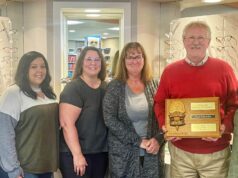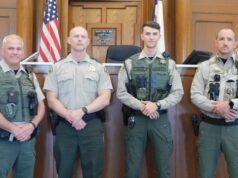Linda Burkhart of the Cherokee Sanford Museum shows a model display of what the Native American Indian Kimball Village may have looked liked during the time the tribe inhabited Plymouth County.
(Le Mars) — The Plymouth County Historical Museum presented a program Sunday afternoon regarding American Indian heritage of Plymouth County. The program was attended by nearly 70 people.
Kimball Village Site, an American Indian village that was active some 800 years ago near the city of Westfield, was the topic at the museum in Le Mars during a Sunday afternoon program.
The site, located along the Big Sioux River near Westfield, was named a National Historic Landmark in January by the U.S. Department of the Interior. Native Americans inhabited the area about 800 years ago, long before the European settlement of what is now the United States. Linda Burkhart serves as the director of the Sanford Planetarium and Museum in Cherokee. She was one of the featured speakers during Sunday’s program. Burkhart says the Kimball Village site is part of the Mill Creek culture which lived along both the Big Sioux and Little Sioux Rivers. She talks about the significance of the Kimball Village.

Burkhart says the tribe was around some 800 years ago, but she says they resided in this area for a duration of perhaps 150 years.
Burkhart isn’t sure as to why the tribe left the area, some archaeologists speculate it may have been because of a more aggressive tribe moved into the area.
A sample of artifacts from the site has been on loan for many years from the Iowa Archeological office in Iowa City to the Sioux City Public Museum. Tom Munson of the Sioux City Public Museum spoke about those and some of the artifacts located at the Plymouth County Museum.
The artifacts were excavated during a 1939 dig at the village and burial mound site in Plymouth County. The 1.9-acre site is located in the Loess Hills and is well-preserved, according to historians. They estimate that between 1,100 and 1,250 Prairie-Plains tribes lived in the area.










